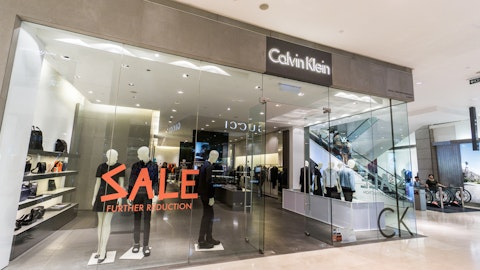Zac Coughlin: Thanks, Stefan, and good morning. My comments are based on non-GAAP results and are reconciled in our press release. As Stefan discussed, we are pleased to report strong third quarter results which exceeded our top line guidance by 2%, delivering underlying revenue growth of 9% versus last year and significantly exceeding our earnings guidance with earnings per share of $2.60. We remain laser focused on what is within our control as we continue to navigate a challenging and increasingly complex macroeconomic environment. And that discipline is reflected in our performance for the quarter. Our underlying revenue growth was driven by strong growth across all regions in both our Tommy Hilfiger and Calvin Klein brands.
We delivered continued solid performance in our international businesses and sequential improvement in North America, driven by the direct-to-consumer business. On just a reported basis, revenue was down 2%, which reflected a 9% negative impact from exchange and a 2% negative impact from the war in Ukraine. We continue to focus on driving performance in our direct-to-consumer business where we have the closest connection to our consumer and DTC was up high single digits on an underlying basis. On a reported basis, DTC revenue was down 5% compared to last year, which reflected a 10% negative impact from exchange and a 2% negative impact from the war in Ukraine. From a regional perspective, we drove underlying growth across all markets. Third quarter revenue for our international businesses was up 7% versus last year on a constant currency basis, continuing to significantly exceed 2019 pre-pandemic levels.
Within our international business, our European business had a record quarter, exceeding €1 billion in revenue for a quarter for the first time ever. Our Asia Pacific business, excluding China, grew nearly 30% compared to last year, even with a negative impact of exchange of 15%. And importantly, we drove mid single digit growth in China in local currency as COVID restrictions there lessened compared to the first half of the year. While we remain optimistic about our business in China, it continues to be a challenging environment as restrictions have once again intensified in the fourth quarter. In North America, revenue in the third quarter was up 10% overall for Tommy Hilfiger and Calvin Klein and above our plans, despite the inflation and interest rate pressures that continue to weigh on consumer sentiment in the region.
Our North America retail store business was up double digits versus last year, even as we continue to be impacted by the lack of international tourism from Asia. And we drove sequential improvement versus the second quarter as we improved inventory levels in store and grew sales to domestic consumers with our comp base now back to 2019 levels. Our wholesale business was also up double digits versus last year. Our global brands also continued to deliver strong underlying growth with Tommy Hilfiger revenues up 7% on a constant currency basis and Calvin Klein revenues up 9% on a constant currency basis. Reported revenues were down 4% for Tommy Hilfiger and up 1% for Calvin Klein. In the third quarter, we delivered gross margin of 55.9%, up approximately 130 basis points compared to pre-pandemic levels, but down approximately 180 basis points compared to last year.
This includes a 40 basis point negative impact of exchange. While gross margin reflected planned price increases, that benefit was more than offset by higher costs and increased promotional selling as inventory levels are elevated across the industry. SG&A expense as a percentage of revenue for the third quarter was better than planned at 46.2% and nearly flat to last year. We continue to take a disciplined approach to managing expenses, driving cost efficiencies while making targeted investments in strategic areas to fuel growth, in line with the fifth growth driver of the PVH+ Plan. We also took actions this quarter to drive initial progress under the plan we announced last quarter to reduce people cost in our global offices by approximately 10% by the end of 2023.
As a reminder, we expect that once completed, these reductions will generate annual cost savings of over $100 million, with a small benefit to 2022 and increased savings as we move through 2023. In total, our EBIT for the quarter exceeded our guidance due to strong revenue performance and lower expenses. Operating margin was 9.6% as reported and 10%, excluding the negative impact of approximately 40 basis points due to exchange. On a GAAP basis, we also took a non-cash goodwill impairment charge of $417 million, which was non-operational and driven by significant increases in discount rates. Earnings per share was $2.60 compared to $2.67 in last year’s third quarter and exceeded the top end of our guidance by $0.45, almost entirely driven by the improvement in EBIT.
Earnings per share for the quarter also included a $0.35 negative impact compared to the prior year related to exchange and an $0.18 negative impact due to the war in Ukraine. Inventory was up 32% at the end of the quarter compared to the prior year period due to a combination of factors. First, inventory levels were abnormally low last year in all regions and consistent with second quarter, we are normalizing to levels that support our plan to growth. Second, as we’ve discussed previously, we have increased our inventory investment in core products to mitigate supply chain and logistics disruptions and ensure that we have the right product at the right time. While supply chain and logistics disruptions have not eased entirely, we have begun to see improvements in on-time delivery and decreases in in-transit times.
And lastly, inventory levels remain elevated in North America wholesale due to lower than expected demand. At the end of Q2, I mentioned that this was worth about 65 million of the increase in inventory versus the prior year. At this point, we have reduced that amount by nearly a third and are on track with our plan to normalize inventory levels in North America. Additionally, we delivered on our commitment under the PVH+ Plan to return excess cash to shareholders returning over $100 million to shareholders during the quarter through the repurchase of 1.9 million PVH shares and our dividend. Moving on to our outlook. To start with, we are reaffirming the top end of our projected revenue guidance, up 4% on a constant currency basis and our EBIT margin outlook of approximately 9%, and we are raising our full year EPS projection to $8.25.
We continue to work relentlessly to drive results even in the face of the challenging macroeconomic environment and trends within the retail industry. Our strong third quarter performance is a testament to our ability to react quickly in the short term, while continuing to be laser focused on strategic actions to support the long-term growth of our business powered by our two global brands, Calvin Klein Tommy Hilfiger. For the full year, we continue to project underlying high single digit revenue growth, in line with our previous guidance. On a reported basis, revenue is projected to be down approximately 3% as reported compared to 2021 and reflects a 7% negative impact from exchange and a 4% reduction resulting from the Heritage Brands transaction, the exit from the Heritage Brands retail business and the war in Ukraine.
We expect total digital penetration as a percentage of revenue to be nearly 25%. We expect our full year gross margin rate to remain significantly above pre-pandemic levels, though approximately 130 basis points below record levels in 2021, which includes the negative impact of exchange of approximately 30 basis points. We continue to expect pressure on our gross margin for the remainder of the year due to promotional selling. Overall, we expect gross margin in the fourth quarter will reflect a similar year-over-year decline versus what we reported for the third quarter, as we offset the negative impact of the increasingly promotional environment by driving our higher margin direct-to-consumer channel as a greater share of the business versus last year.
We continue to take a disciplined approach to manage expenses across the business in light of increased macro pressures weighing on our gross margin and we are accelerating cost efficiencies while prudently investing in the core pillars of the PVH+ Plan. SG&A expense as a percentage of revenue for the full year reflects an approximately 60 basis points improvement compared to our previous guidance and is now expected to be approximately 40 basis points higher compared to 2021. Our full year operating margin projection continues to be approximately 9% and reflects a negative impact compared to last year of approximately 40 basis points due to exchange. Our interest expense projection is unchanged at approximately $85 million, and we continue to expect our corporate tax rate will be approximately 24%.
For the full year 2022, we are raising our projected earnings per share to be approximately $8.25 compared to our previous guidance of $8.00. The increase versus our previous guidance is primarily due to our strong Q3 performance. Our planned stock repurchase in 2022 remain at approximately $400 million, with approximately 330 million of repurchases completed year-to-date. For the fourth quarter, we are projecting mid single digit revenue growth in our underlying business. On a reported basis, revenue is projected to be down approximately 4% as compared to 2021 and reflects an 8% negative impact from exchange and a 2% negative impact from the war in Ukraine. Fourth quarter earnings per share is expected to be approximately $1.65, which reflects the negative impacts of approximately $0.27 due to exchange and approximately $0.15 from the war in Ukraine compared to the prior year.
We expect our tax rate in this year’s fourth quarter will be an expense of approximately 25%, which is relatively in line with our full year rate expectation. As a reminder, in last year’s fourth quarter, we benefited from non-cash tax rate relief tied to our purchase of the Calvin Klein brand back in 2003. This benefit ran out in 2021. As a result, our tax rate in the fourth quarter of last year was a benefit of approximately 33%. We expect our interest expense for the fourth quarter to be approximately $24 million. Before we open it up for questions, I want to reiterate that we are pleased with our strong third quarter results and that we were able to continue to drive strong underlying growth across the business even in the tough macroeconomic environment.
We remain focused on driving our strategic priorities despite the continued volatility. Through the PVH+ Plan, our global brands and businesses are well positioned to drive long-term value creation and deliver sustainable profitable growth and shareholder returns. And with that operator, we would like to open it up to questions.
Follow Pvh Corp. (NYSE:PVH)
Follow Pvh Corp. (NYSE:PVH)
Operator: Thank you. . Our first question will come from Bob Drbul with Guggenheim. Your line is now open.
Bob Drbul: I guess the question that I’d actually like to spend some time on if you could is, Stefan, can you just talk us through the strategic rationale for taking the G-III licenses back and sort of how you structured them and why now and sort of how you really approach this? I think that will be pretty helpful. Thanks.
Stefan Larsson: Absolutely. Thank you, Bob. So as we communicated yesterday, we are extending the licensing agreement with G-III in a way that over a multiyear period will bring these categories back in house. And the rationale for that is very much connected to the PVH+ Plan and what that is about, because, in essence, the PVH+ Plan is a growth plan. It’s a brand-driven growth plan. So it’s about unlocking the full potential of our brands. And the brands, both Calvin and Tommy are the brands for the most valuable assets we have. So when we look at over time, over the next few years, in housing this, it’s about giving us complete control of those brands. So when you look at the PVH+ Plan, we have five growth drivers and this very much connect to what creates value in unlocking those brands.
So product design, the product assortment, the pricing, the market channel mix, enabling us to connect to demand-driven supply chain, so all those parts are value-creating growth drivers and that’s what we will be able to be in control of and it will help unlock more of Calvin and Tommy and bigger value creation over time. But it will also help us build Calvin and Tommy to truly global cohesive aspirational lifestyle brands.
Zac Coughlin: Yes. And then maybe, Bob, I can give a bit of context from an economics perspective to complement the strategic element to this. So first of all, I think it’s useful to size the current business impact. These are predominantly U.S. women’s wholesale categories for Calvin Klein and Tommy Hilfiger. And today these licenses make up approximately one third of our global licensing revenue. And from a profit perspective, the profit comprised less than 10% of our 2021 EBIT. I think also important to note is that due to the structure of the agreement, we do not expect any material impact to our financial results between now and the end of our PVH+ Plan commitments in 2025. Beyond that, in 2026 and beyond, we do expect the impact to become more material. We expect the intake of this business will be accretive to our financial results as we take advantage of the scale of what the rest of the business has.
Bob Drbul: Great. Thank you very much.
Operator: Thank you. Our next question will come from Michael Binetti with Credit Suisse. Your line is now open.
Michael Binetti: Hi, guys. Thanks for all the detail today. Congrats on a nice quarter. I know it’s a tough backdrop. I guess a quick one on the model, Zac, for the EBIT guidance in fourth quarter. It seems like it implies a decent step up relative to third quarter on both a year-over-year and a three year basis. Maybe you could unpack that a little bit. How much of that’s cost savings or mix dynamics? Help us understand that a little. And then I guess what I found interesting was the U.S. DTC comments to stores. Stefan, I know this has been a focus for you. It seems like there’s a bigger unlock emerging there. I know you said — I think you said domestic consumer traffic across the back above 2019 levels for the first time.
It’s great to hear and even fighting that hard. I think you told us 30% of sales in those doors, or at least in the outlet doors was tourist volume. Maybe talk a little bit about how far below 2019 levels those doors are today in productivity and in margins and what you think are some realistic medium-term expectations for how much those can progress back to pre-COVID levels?




